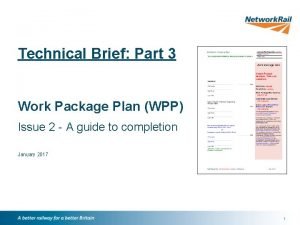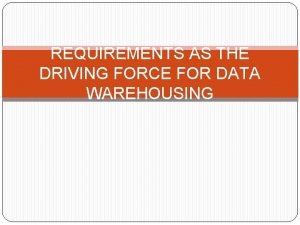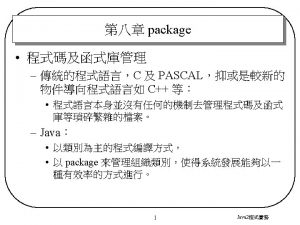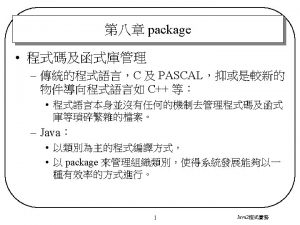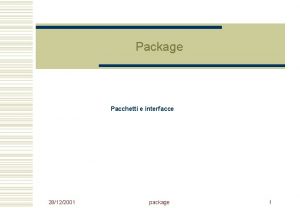Work Package 2 From data theoretic to knowledge









- Slides: 9

Work Package 2 From data theoretic to knowledge theoretic approaches to flood modelling Dr Nick Odoni and Professor Stuart Lane University of Durham

Work Package 2 aims • To develop a Minimum Information Requirement model for flood risk – Focus on diffuse land management activities – Primarily using secondary data sets and new data where necessary • To evaluate model performance – sensitivity and propagation of uncertainty – formal model assessment • To simulate the effects of diffuse land management impacts on flood risk • To undertake this work within the framework of Environmental Competency Groups (see Work Package 3)

Philosophy Odoni and Lane, in press, Progress in Physical Geography Model-Theoretic Data Theory Experience Model-Data

Making models ‘But then you don’t even have to have reservoirs as such. You could have a dam with a restricted outflow so it literally holds it back and releases it slowly…so the stream normally just runs straight through it and doesn’t get stopped…’ [Local member] • ‘And the other problem is that once you get down to Newtondale, you have got the railway there, which means you are causing problems at the railway, they are not going to be pleased about that. ’ [Local member] Perceptualisation, conceptualisation, framing, of the problem • What to try where • Why things won’t work ‘the man has taken the flood banks down. . . • Why things (e. g. data) and he’s put a bridge across the river at that are wrong point, and the bridge is an old articulated lorry body, which enables him to go backwards and forwards with his farm implements when he’s making silage, then ‘So to protect Pickering, the nearer the information that they would be able to the dams are to Pickering the collect from Ings Bridge would be better? ’ [Local member 1] ‘Well useless…Because it wouldn’t be going yes certainly’ [Local member 2] through the gauge, it would be going over land. ’ [Local member]

• • • The models Bunding – Pickering Assumes conditions of high Standard Percentage Runoff Identifies a critical flood onset – which becomes the target to which flows must be reduced Determines flow directions across the landscape using digital topographic data Applies a rainfall rate to those flow directions Routes the associated rainfall Produces a flow discharge rate at every point in the catchment Provides a simple interactive tool to place multiple holy bunds – enter their characteristics – assess the duration that they can store water for – in relation to preventing flows at Pickering reaching the critical flood onset Validation by comparison with ISIS-TUFLOW

Overflow Uckfield and Pickering The models • Assumes conditions of high Standard Percentage Runoff • Identifies a critical flood onset - which becomes the target to which flows must be reduced • Determines flow directions across the landscape using digital topographic data • Applies different rainfall rates to those flow directions • Routes the associated rainfall for each rainfall rate • Allows depth dependent routing rates • Samples from routing rates according to event rainfall • Integrated into time-dependent travel time maps, which are convolved with timedependent rainfall rates, to provide timevarying flow discharge at every point in the catchment • Development for uncertainty and scenario analysis in Pickering • Interventions §Remeandering §Riparian vegetation §Debris dams §Channel reprofiling §Hedgerows §Woodland belts §Bunds • Demonstration available, for Uckfield, during Conference

Bunding : a demonstration • Files we prepared earlier – Pit filling – Flow routing (FD 8 on hillslopes, D 8 in channels) – Cut the catchment – Order the channel networks • Our demonstration – Stage I • Place the dams • Calculate potential storage according to bund height – Stage II • Test impacts on flood flow to identify how long Pickering (in this example) can be protected for at a given rain rate

Hybrid models Thegeneric ‘peculiar’ model • • Models as a form of ‘covering law’ – the model can ‘travel’ ‘Hybrid’ models: – the loss of the ‘generic’ rationale (but aren’t all models hybrid? ) – the loss of technological lock-in: the models are forced to mutate The specific case The calibrated model

Participating Institutions Funding Body http: //knowledge-controversies. ouce. ox. ac. uk/
 Work package plan template
Work package plan template Construction work packages
Construction work packages Briefing package example
Briefing package example Technical data packages
Technical data packages Information package diagram in data warehouse
Information package diagram in data warehouse Information package diagram in data warehouse
Information package diagram in data warehouse Personal and shared knowledge
Personal and shared knowledge Knowledge shared is knowledge squared meaning
Knowledge shared is knowledge squared meaning Knowledge shared is knowledge multiplied interpretation
Knowledge shared is knowledge multiplied interpretation Knowledge creation and knowledge architecture
Knowledge creation and knowledge architecture
